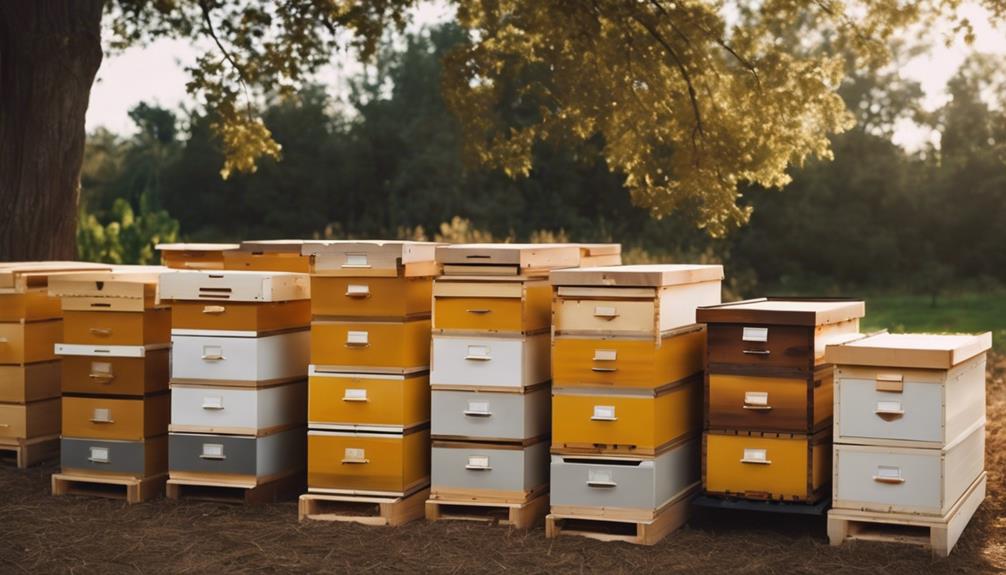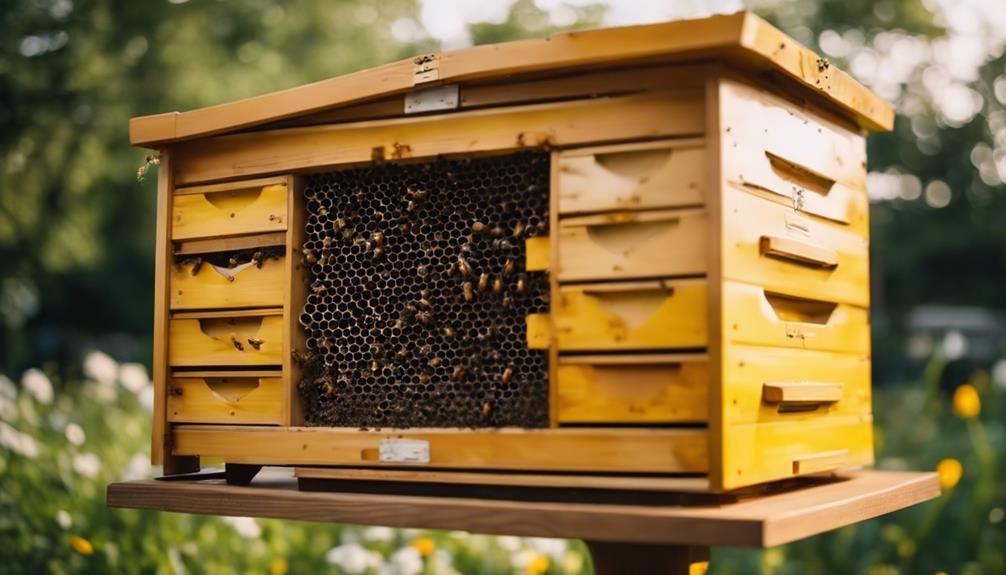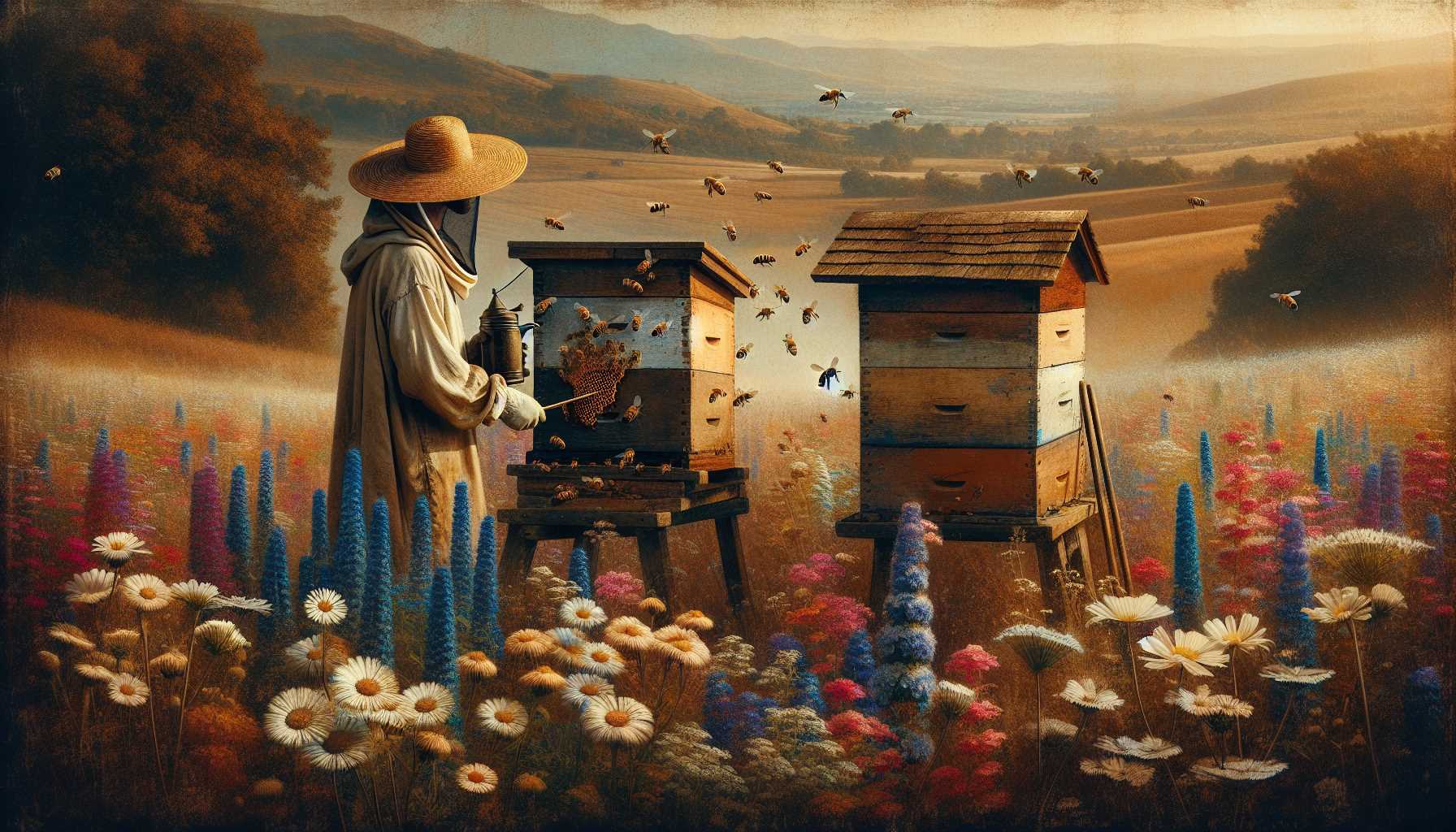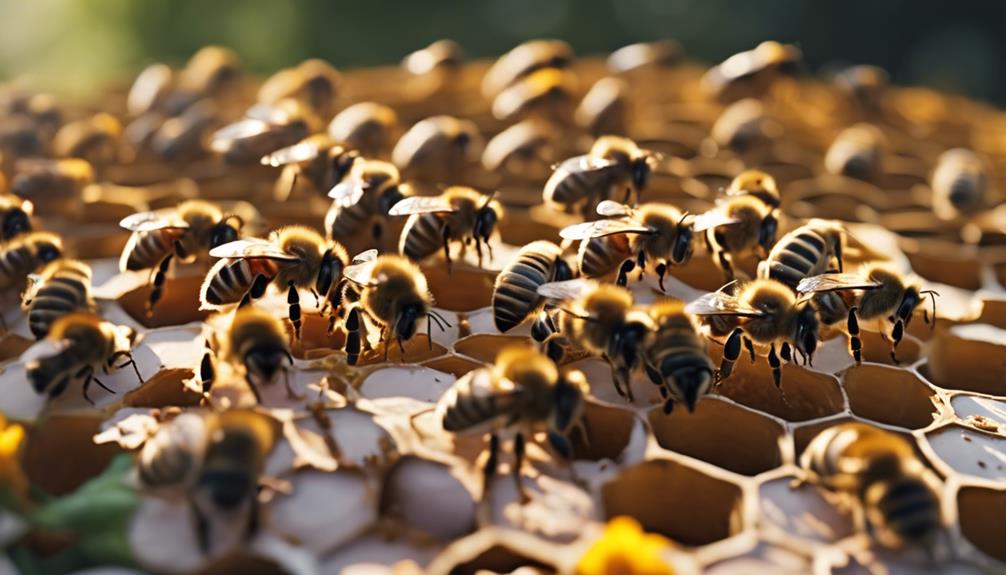When starting out in beekeeping, the Langstroth hive is our top pick for beginners. This hive’s movable-frame design offers efficiency and ease of use, laying a strong foundation for your beekeeping journey. With standardized dimensions and extensive support from the beekeeping community, Langstroth hives make managing bees a breeze. Plus, they support honey production and bee health like a pro. If you’re curious about why this classic hive is a go-to for new beekeepers, keep exploring to uncover more beehive wisdom.
Main Points
- Langstroth hives are best for beginners due to their efficiency and ease of use.
- Top bar hives offer a more natural approach but require more upkeep.
- Hive size impacts management ease, smaller hives are recommended for beginners.
- Hive material like FSC® certified wood ensures longevity and eco-friendliness.
- Langstroth hives provide ample support, guidance, and easy access to supplies for beginners.
Langstroth Hive Overview
The Langstroth hive, designed by Lorenzo Lorraine Langstroth in 1852, transformed modern beekeeping with its movable-frame design. Langstroth hives, with their standardized dimensions and various frame options, are the best beehive for beginners looking to start their beekeeping journey.
These hives offer efficiency and ease of use, making them a favorite among beekeepers. The Langstroth style hive has stood the test of time, remaining a popular choice due to its practicality and functionality.
Whether you opt for a 5, 8, or 10 frame setup, the Langstroth hive provides a solid foundation for your beekeeping endeavors. Its design may be simple, but its impact on beekeeping is profound, offering both freedom and structure to beekeepers of all levels.
Top Bar Hive Comparison
Comparing top bar hives to Langstroth hives reveals distinct differences in comb structure and maintenance requirements. Top bar hives, with their bars for comb building, offer a more natural approach to beekeeping. Here are some key points to think about when contemplating top bar hives:
- Top bar hives are beginner-friendly, emphasizing a simpler hive design without frames.
- These hives require more frequent inspection and upkeep to guarantee bee health.
- During inspections, the delicate nature of top bar hive comb means extra care is needed to prevent breakage.
Choosing a hive style is all about finding the right balance between hands-on involvement and bee well-being. Top bar hives offer a unique experience for those seeking a more hands-on approach to beekeeping.
Hive Styles for Beginners

When starting beekeeping as a beginner, exploring different hive styles is crucial for finding the right fit for your needs and goals. Langstroth hives are a top choice for beginners because of their beginner-friendly nature. They come with extensive support and resources from the beekeeping community, making the learning process smoother.
These hives are designed to promote honey production and maintain healthy bees, which aligns perfectly with the goals of new beekeepers. With standardized dimensions and easy availability of equipment, Langstroth hives simplify the beekeeping journey.
The 4-sided frames of Langstroth hives make them easier to operate compared to other hive styles, ensuring beginners can start their beekeeping adventure with confidence and success.
Factors for Hive Selection
When choosing a beehive as a novice, it’s crucial to contemplate factors such as hive size and material. These aspects have a substantial impact on the simplicity of beekeeping and upkeep.
Aligning these elements with your requirements guarantees a more seamless beginning in your beekeeping adventure.
Hive Size
Considering the available space and beekeeping goals will guide the selection of the appropriate hive size for beginners entering the world of beekeeping. When it pertains to hive size, there are a few key factors to keep in mind:
- Colony Size: Larger hives, like the 10-frame Langstroth, can accommodate bigger bee populations, which can lead to higher honey production.
- Honey Production: If your main aim is honey production, a larger hive size might be more suitable due to its increased capacity.
- Beginner-Friendly: On the other hand, smaller hives, such as the 8-frame Langstroth, are often recommended for beginner beekeepers as they’re easier to manage and maintain.
Choosing the right hive size is pivotal for a successful beekeeping journey tailored to your specific needs and goals.
Hive Material
Selecting the appropriate hive material is a crucial decision for beginners starting out with beekeeping, as it impacts the hive’s longevity and the well-being of the bee colony. When considering hive material options such as Western red cedar, Douglas fir, or Sugar pine, it’s important to prioritize durability and sustainability.
Western red cedar stands out as a premium choice with its FSC® certification, ensuring both quality and eco-friendliness. Douglas fir, another FSC® certified wood, offers durability, while Sugar pine provides stability and is lightweight, ideal for beekeeping beginners.
Opting for wood options not only ensures natural resistance to rot but also aligns with sustainable practices. Remember, choosing FSC® certified wood for your beehive is a commitment to quality craftsmanship and environmental responsibility.
Benefits of Langstroth Hives

Langstroth hives offer numerous benefits to beginner beekeepers, making them a popular choice in the beekeeping community.
- Langstroth hives provide easy access to equipment and supplies, simplifying the process of starting beekeeping.
- The design of Langstroth hives with 4-sided frames is straightforward, making them simple to operate and maintain.
- These hives are known for promoting honey production efficiently, supporting both the beekeeper’s harvest and the bees’ well-being.
Choosing a Langstroth hive can set you up for success as a new beekeeper, with its widespread use ensuring plenty of resources and guidance along the way. Whether you’re drawn to beekeeping for the sweet rewards of honey or the joy of supporting these essential pollinators, a Langstroth hive can be a fantastic starting point.
Choosing the Right Hive for You
Shifting from the advantages of Langstroth hives to the conversation on choosing the appropriate hive, our attention now moves to discovering the most fitting hive for your beekeeping journey.
When getting started as a new beekeeper, the type of beehive you select is vital. There are various hive styles to contemplate, each with its own unique features and benefits. As a beginner, it’s recommended to start with a Langstroth hive due to its widespread use and beginner-friendly design.
This type of beehive offers easy availability of equipment, standardized frames for easier management, and promotes healthy bee colonies while supporting honey production. Starting with a Langstroth hive can provide you with a solid foundation as you commence on your beekeeping adventure.

Roger Thomas is a seasoned beekeeper and hive architect with a deep-seated passion for sustainable living. His fascination with bees has shaped his professional career, giving him practical and theoretical expertise in bee behavior, colony health, and optimal hive conditions. Roger’s technical skills shine in his bespoke hive creations that cater to the specific needs of diverse bee species, while his sustainable practices promote environmental balance and the wellbeing of the bee population.
As he continues his journey in beekeeping, Roger has become a dedicated advocate for responsible practices and an insightful educator in his field. His posts aim to inspire new beekeepers, underline the importance of sustainability, and showcase the remarkable contribution bees make to our ecosystem. Roger invites you to join him as he delves into the world of bees and the rewarding, honey-sweet art of beekeeping.


